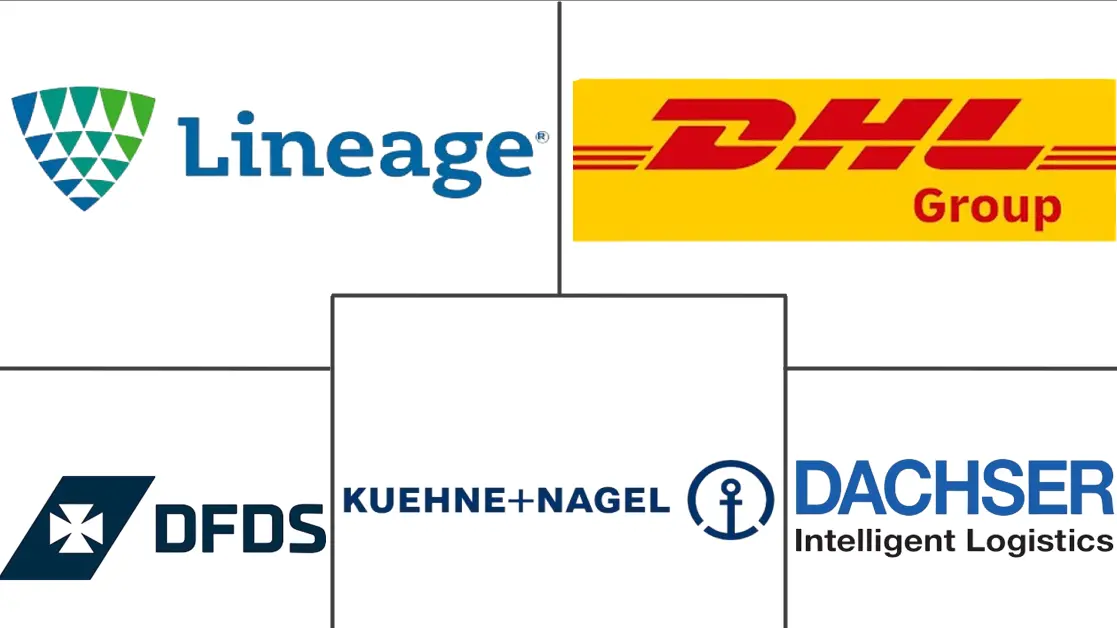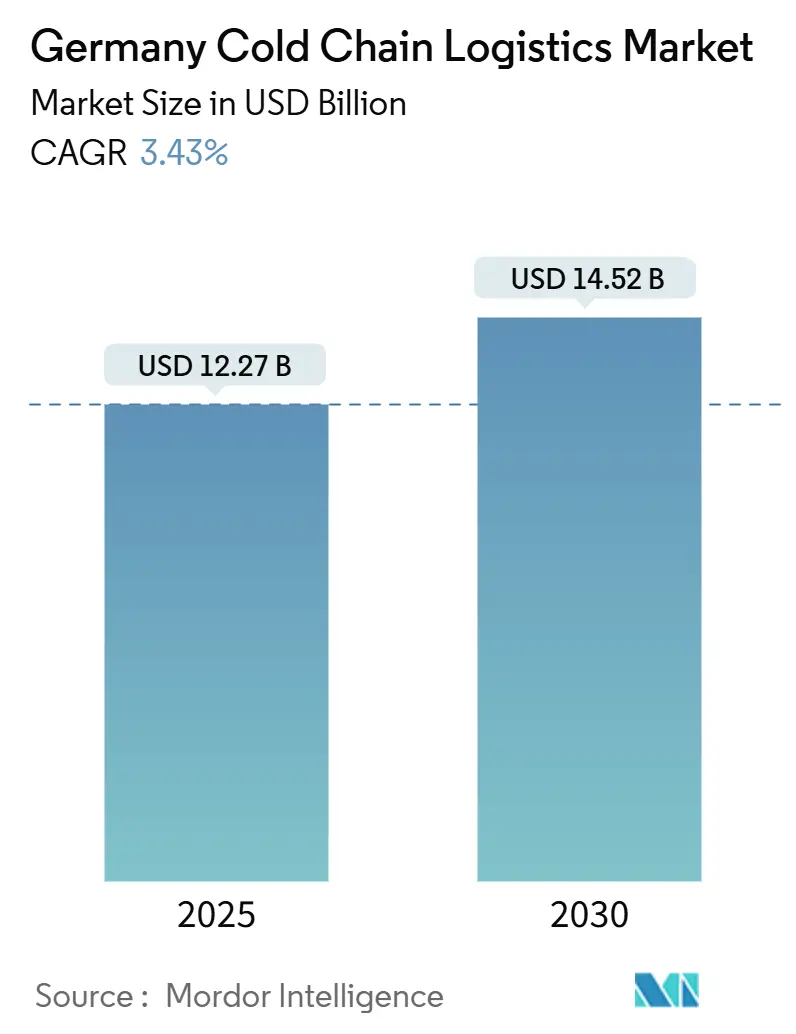
Germany Cold Chain Logistics Market Analysis by Mordor Intelligence
The Germany Cold Chain Logistics Market size is estimated at USD 12.27 billion in 2025, and is expected to reach USD 14.52 billion by 2030, at a CAGR of 3.43% during the forecast period (2025-2030).
Robust e-commerce grocery demand, sustained biologics export momentum, and retailer investments in automated freshness programs underpin near-term expansion, while natural-refrigerant retrofits and electrified transport fleets reinforce long-term efficiencies. Established third-party logistics providers are digitalizing networks with IoT tracking, predictive maintenance, and AI-driven route optimization to contain rising energy costs and comply with tightening environmental rules. Portfolio diversification into ultra-low-temperature storage and integrated value-added services is widening margins as clients look for end-to-end compliance solutions. The Germany cold chain logistics market continues to benefit from the country’s geographic position at the heart of European trade lanes and from public incentives supporting sustainable infrastructure upgrades[1]“German foreign trade: Exports up 0.6% and imports down 3.3% in 2024,” Federal Statistical Office, destatis.de.
Key Report Takeaways
- By service type, refrigerated transportation held 61% of the Germany cold chain logistics market share in 2024, while value-added services are projected to grow at a 4.8% CAGR to 2030.
- By temperature range, chilled storage accounted for 55% of the Germany cold chain logistics market size in 2024; the frozen segment is set to expand at a 4.1% CAGR through 2030.
- By application, meat & seafood led with a 32% revenue share in 2024, whereas pharmaceuticals & biologics are forecast to register the fastest 5.7% CAGR during the outlook period.
Germany Cold Chain Logistics Market Trends and Insights
Drivers Impact Analysis
| Driver | ( ~ ) % Impact on CAGR Forecast | Geographic Relevance | Impact Timeline |
|---|---|---|---|
| E-commerce-led rise in B2C grocery fulfillment | +0.8% | Nationwide; early traction in North Rhine-Westphalia, Bavaria, Baden-Württemberg | Short term (≤ 2 years) |
| Growth of biologics & mRNA-based pharma exports | +1.2% | National; clusters around Frankfurt, Munich, Berlin | Medium term (2-4 years) |
| Retailer push for “Doppelte Frische” private labels | +0.5% | Nationwide; premium retail focus | Medium term (2-4 years) |
| Surge in EV-compatible multi-temp truck bodies | +0.6% | Urban centers country-wide | Medium term (2-4 years) |
| Near-shoring of seafood processing to North Sea ports | +0.3% | Hamburg and Bremen corridors | Long term (≥ 4 years) |
| Tax incentives for ammonia/CO₂ natural-refrigerant retrofits | +0.4% | Nationwide, industrial regions | Long term (≥ 4 years) |
| Source: Mordor Intelligence | |||
E-commerce-led rise in B2C grocery fulfillment
Online fresh-food sales reached USD 3.2 billion in 2024 and are expected to climb a further 15-20% in 2025, prompting retailers and pure-play operators to build micro-fulfillment centers equipped with dual-zone automation that can process 1,000 orders per hour at 2°C and ambient temperatures. Electric-vehicle delivery fleets, as adopted by Aldi’s “Mein Aldi” and Picnic’s hub model, reduce emissions and meet strict urban noise caps. Smaller basket sizes and shorter delivery windows have shifted cost structures toward high-velocity, data-driven routing tools. Logistics providers now deploy predictive analytics to re-sequence drops by thermal sensitivity, trimming spoilage and last-mile mileage. These operational upgrades accelerate the Germany cold chain logistics market’s service standard while enlarging its addressable consumer base.
Growth of biologics & mRNA-based pharma exports
Germany exported EUR 105.8 billion (USD 116.76 billion) in pharmaceuticals during 2024, with temperature-sensitive biologics providing the fastest lift. DHL Group alone is investing EUR 2 billion (USD 2.20 billion) by 2030 in GDP-certified hubs, sensing equipment, and multi-temperature fleets to safeguard biologics and cell-therapy shipments. Biotech corridors around Frankfurt and Munich now demand continuous −70 °C to +25 °C visibility, triggering upgrades in real-time tracking, chain-of-custody documentation, and AI-enabled cooling optimization. These capabilities cement Germany’s role as the preferred European export gateway for novel therapies, boosting premium service revenue across the Germany cold chain logistics market.
Retailer push for “Doppelte Frische” (Double-Fresh) private labels
Premium chains such as REWE and Edeka mandate twice-daily freshness checks, supported by robotics and AI inventory tools that cut handling time and protect thermal integrity. The policy extends to prepared foods, dairy, and meat, creating dependable volume for specialized packs, rapid cross-docking, and enhanced quality audits. Logistics providers supplying these programs generate higher contract retention and differentiated margins, reinforcing the Germany cold chain logistics market’s shift from commodity transport toward integrated quality assurance services.
Surge in EV-Compatible multi-temp truck bodies
Government subsidies covering 80% of incremental EV costs and the pledge for 1 million public chargers by 2030 encourage the adoption of low-noise refrigerated trucks. Hybrid cooling units running on diesel and battery maximize route flexibility while keeping decibel levels under the 60 threshold enforced by major cities. Early field trials show fuel-equivalent energy savings of up to 86% through predictive power management[2]“Predictive Energy Management for Recuperation Axles in Refrigerated Trailers,” ArXiv, arxiv.org. Fleet operators thus secure access to urban low-emission zones, extend nighttime delivery windows, and reduce carbon footprints aligned with national targets.
Restraints Impact Analysis
| Restraint | ( ~ ) % Impact on CAGR Forecast | Geographic Relevance | Impact Timeline |
|---|---|---|---|
| Scarcity of licensed refrigeration technicians | -0.9% | Nationwide, industrial centers | Short term (≤ 2 years) |
| Grid-energy price volatility for large cold stores | -0.6% | Nationwide, energy-intensive sites | Medium term (2-4 years) |
| Patchwork municipal noise-emission limits on night-time deliveries | -0.4% | Urban areas | Short term (≤ 2 years) |
| Lengthy planning approvals for green-field warehouses | -0.3% | Nationwide | Long term (≥ 4 years) |
| Source: Mordor Intelligence | |||
Scarcity of licensed refrigeration technicians
More than 60% of open refrigeration jobs remained unfilled in 2024, reflecting an aging workforce and limited new entrants, particularly women. Shortfalls elevate maintenance lead times and service costs, compelling operators to deploy remote diagnostics and predictive maintenance[3]“Förderung für energieeffiziente Kälte- und Klimaanlagen,” Klimaschutz.de, klimaschutz.de. Apprenticeship reforms are in place, yet the Germany cold chain logistics industry faces at least a two-year skill-gap overhang.
Grid-Energy price volatility for large cold stores
Forward curves indicate electricity could rise to 37-42 cents/kWh by 2042. A 38.4 kW/38.4 kWh battery pack can shave 33.8 kW in peak demand, saving EUR 980 (USD 1,081.57) annually in a standard installation. Expanded grid-scale storage forecast to hit 271 GWh by 2050 will eventually dampen price spikes. Until then, energy volatility pressures margins across high-capacity warehouses in the Germany cold chain logistics market.
Segment Analysis
By Service Type: Transportation dominates while Value-Added Services accelerate
Refrigerated transportation supplied 61% of 2024 revenue, underscoring Germany’s status as a pan-European gateway where motorway, rail, sea, and air corridors interlock to move temperature-controlled cargo efficiently[4]“EU reports shortage of RAC technicians,” International Institute of Refrigeration, iifiir.org. Hegelmann Group’s deployment of 200 telematics-enabled Thermo King units exemplifies the segment’s technological edge. Over the forecast horizon, automation and EV adoption will continue to smooth cross-border flows and guarantee integrity for biologics and premium grocery lines.
Value-added services are forecast to expand at a 4.8% CAGR, the fastest within this classification. Rising regulatory burdens around GDP and HACCP compliance fuel demand for specialized packaging, batch-level monitoring, and documentation support. Storage operators such as Lineage Logistics are integrating automated pick-and-pack systems and real-time dashboards that merge warehousing, transport, and compliance activities into single-service agreements. The Germany cold chain logistics market size for value-added solutions is therefore primed for multi-year compound expansion as manufacturers outsource complexity and regulators tighten oversight.
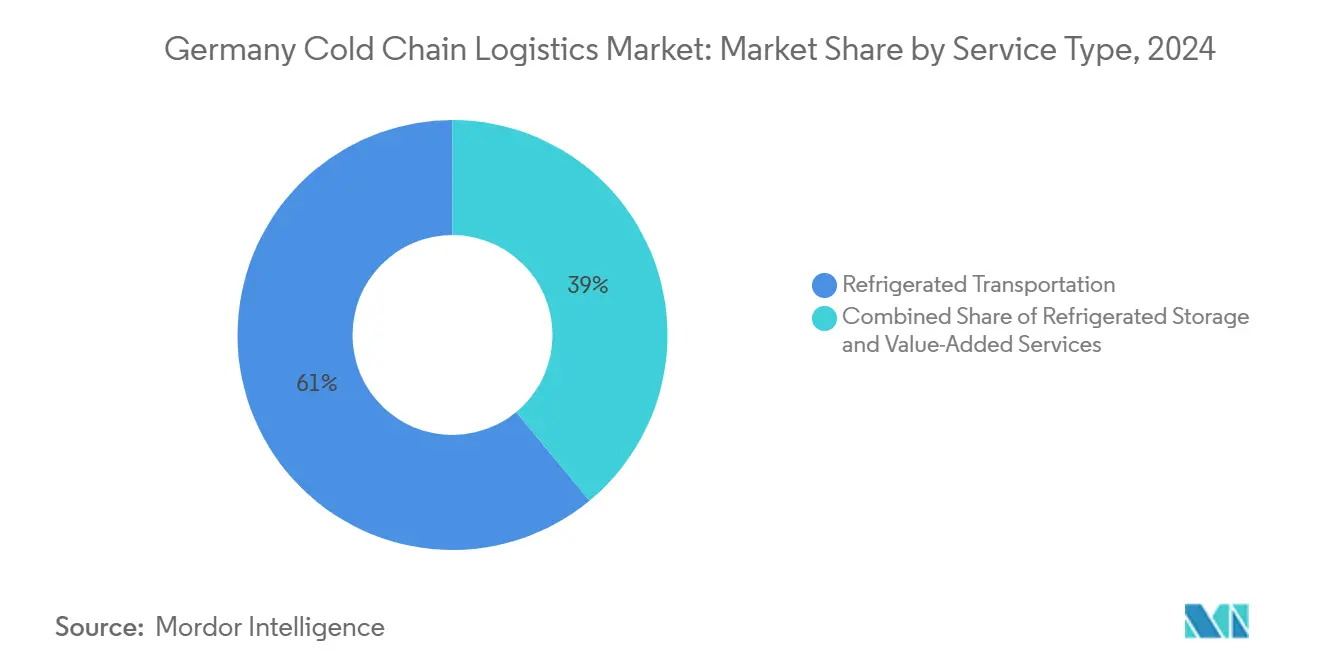
Note: Segment shares of all individual segments available upon report purchase
By Temperature Type: Frozen momentum outpaces chilled leadership
Chilled rooms between 0 °C and 5 °C accounted for 55% of 2024 turnover, anchored by vaccine distribution and daily grocery restocking. Retailers depend on energy-efficient chill corridors that support “Doppelte Frische” product rotations, reinforcing capital expenditure in modern compressors and predictive controls.
The frozen category is projected to grow at 4.1% CAGR through 2030, buoyed by specialty frozen supermarkets and the clustering of seafood processors along the North Sea. Natural-refrigerant deep-freeze systems are cutting electricity use by up to 50%, widening retailer assortment while protecting margins. Ultra-low zones below −20 °C, vital for mRNA therapies, represent a high-value niche that commands premium pricing and draws continuous R&D investment. Broad adoption of IoT probes and AI thermodynamic modeling further secures product integrity across the Germany cold chain logistics market.
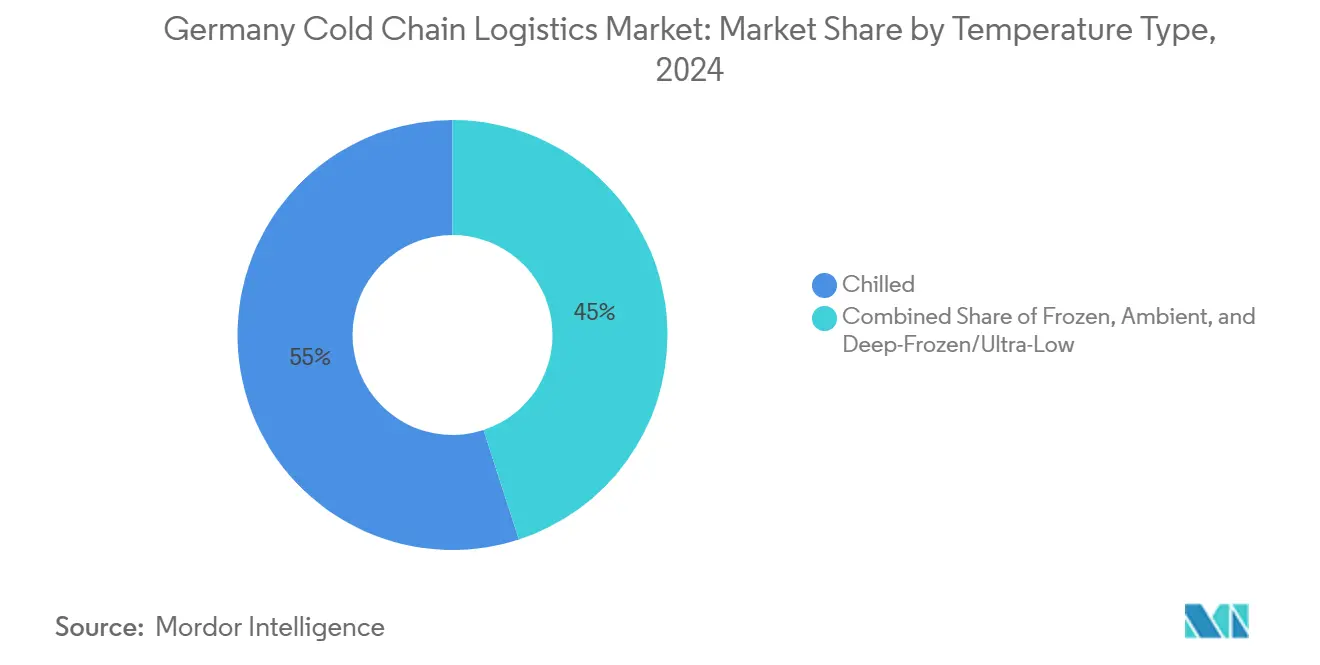
Note: Segment shares of all individual segments available upon report purchase
By Application: Pharmaceuticals sprint past traditional food strongholds
Meat & seafood held a 32% revenue contribution in 2024 thanks to Bremen-Bremerhaven’s processing infrastructure and Hamburg’s reefer capacity. Automated fish lines and fast quayside transfers keep proteins fresh while trimming carbon footprints through reduced road miles. Fruits & vegetables and dairy products maintain steady demand, supported by robotic palletizing and photo-spectrometric quality checks that narrow spoilage rates.
Pharmaceuticals & biologics are expected to rise at a 5.7% CAGR. Frankfurt’s air-cargo hub, proximity to large CDMOs, and considerable venture funding in gene-therapy pipelines all spur build-outs of GDP facilities and ultra-cold chambers. UPS’s cross-dock expansion near Frankfurt Airport illustrates how express operators add multi-temperature zones to serve global routes. These layers of premium, compliance-driven services will continue to tilt growth toward healthcare cargo inside the Germany cold chain logistics market.
Geography Analysis
Germany’s cold chain activity gravitates toward North Rhine-Westphalia, Bavaria, and Baden-Württemberg, which concentrate industrial production, consumer density, and multimodal nodes. DHL Freight’s 5,200 m² Berlin-Marienfelde site with 48 loading doors showcases the region’s scale and commitment to sustainable assets.
Northern ports provide disproportionate throughput given their smaller populations. Hamburg deploys automated Reefer Runner tech that scans container temperatures in real time, raising dock productivity and safeguarding perishables. Bremerhaven offers 27,000 pallets of ambient-to-deep-freeze capacity and processes large fruit and seafood volumes, making it Europe’s pivotal fish logistics hub.
Eastern states constitute the next expansion frontier as EU funding accelerates road and rail upgrades, land costs remain moderate, and cross-border access to Poland and the Czech Republic improves. Providers targeting these corridors can balance network loads, reduce final-mile distances, and mitigate congestion risk in western metros. Regional specialization thereby sustains diverse revenue streams within the Germany cold chain logistics market.
Competitive Landscape
Market structure remains fragmented. Consolidation is gathering pace, illustrated by DSV’s planned EUR 14.3 billion (USD 15.78 billion) acquisition of Schenker, which will create a global top-five logistics operator with a EUR 1 billion (USD 1.10 billion) domestic investment pledge.
Digital capability has become a primary differentiator. Hellmann Worldwide Logistics partners with Geekplus robotics to automate picking for e-commerce clients, while launching marine biofuel insetting programs to meet Scope 3 carbon goals. DHL Group channels EUR 2 billion (USD 2.20 billion) into pharma-grade hubs and predictive telemetry for biologics traffic.
White-space opportunities persist in ultra-low-temperature nodes, micro-fulfillment for online grocery, and ammonia-based refrigeration retrofits. Providers that blend regulatory expertise, automation, and ESG credentials are best placed to secure multiyear contracts and uplift margins in the Germany cold chain logistics market.
Germany Cold Chain Logistics Industry Leaders
-
Kuehne + Nagel International AG
-
DHL Group
-
Lineage Logistics LLC
-
Dachser SE
-
DFDS Logistics
- *Disclaimer: Major Players sorted in no particular order
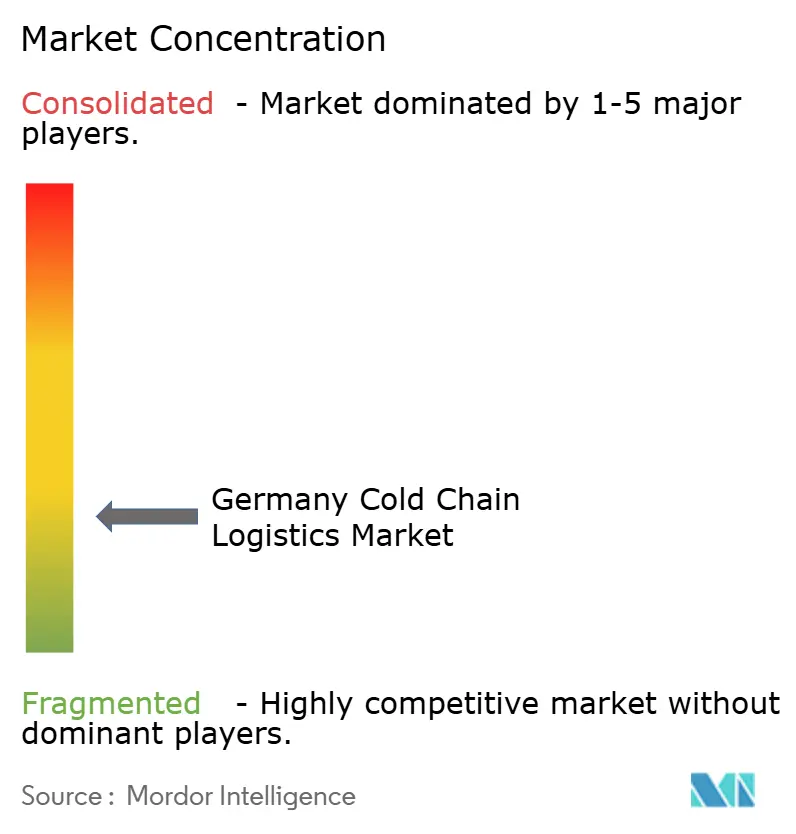


Recent Industry Developments
- April 2025: DSV agreed to acquire Schenker AG from Deutsche Bahn for EUR 14.3 billion (USD 15.78 billion) , targeting Q2 2025 completion pending approvals.
- April 2025: DHL Group committed EUR 2 billion to expand DHL Health Logistics, adding GDP-certified hubs and temperature-controlled vehicles across Europe.
- January 2025: DHL Freight opened a 5,200 m² terminal in Berlin-Marienfelde featuring electric trucks and on-site renewables.
- February 2024: Lineage Logistics commissioned a 19,000 m² quay-side cold store in Bremerhaven with 40,000 pallet positions.
Germany Cold Chain Logistics Market Report Scope
Cold chain is a logistics management process for products that require the refrigerated temperatures that customers need. A cold chain is a low-temperature-controlled supply chain network. An unbroken cold chain is an uninterrupted series of refrigerated production, storage, and distribution activities, along with associated equipment and logistics, that maintain quality within a desired low-temperature range. It is used to preserve, extend, and ensure the shelf life of products.
The German cold chain logistics market is segmented by service (storage, transportation, and value-added services), temperature type (ambient, chilled, and frozen), and application (agriculture, dairy products, meat and seafood, processed food products, pharmaceuticals, life sciences, chemicals, and other applications). The report offers market sizes and forecasts in terms of value (USD) for all the above segments.
| Refrigerated Storage | Public Warehousing |
| Private Warehousing | |
| Refrigerated Transportation | Road |
| Rail | |
| Sea | |
| Air | |
| Value-Added Services |
| Chilled (0-5°C) |
| Frozen (-18 to 0°C) |
| Ambient |
| Deep-Frozen / Ultra-Low (less than-20°C) |
| Fruits and Vegetables |
| Meat and Poultry |
| Fish and Seafood |
| Dairy and Frozen Desserts |
| Bakery and Confectionery |
| Ready-to-Eat Meals |
| Pharmaceuticals and Biologics |
| Vaccines and Clinical Trial Materials |
| Chemicals and Specialty Materials |
| Other Perishables |
| By Service Type | Refrigerated Storage | Public Warehousing |
| Private Warehousing | ||
| Refrigerated Transportation | Road | |
| Rail | ||
| Sea | ||
| Air | ||
| Value-Added Services | ||
| By Temperature Type | Chilled (0-5°C) | |
| Frozen (-18 to 0°C) | ||
| Ambient | ||
| Deep-Frozen / Ultra-Low (less than-20°C) | ||
| By Application | Fruits and Vegetables | |
| Meat and Poultry | ||
| Fish and Seafood | ||
| Dairy and Frozen Desserts | ||
| Bakery and Confectionery | ||
| Ready-to-Eat Meals | ||
| Pharmaceuticals and Biologics | ||
| Vaccines and Clinical Trial Materials | ||
| Chemicals and Specialty Materials | ||
| Other Perishables | ||


Key Questions Answered in the Report
What was the value of the Germany cold chain logistics market in 2025?
It totaled USD 12.27 billion and is projected to reach USD 14.52 billion by 2030.
Which service category currently dominates Germany’s temperature-controlled logistics?
Refrigerated transportation holds 61% of 2024 revenue.
Which application segment is growing fastest?
Pharmaceuticals & biologics are forecast to post a 5.7% CAGR through 2030.
What policy supports natural-refrigerant adoption in German warehouses?
The Kälte-Klima-Richtlinie scheme provides grants for ammonia and CO₂ retrofits through 2026.
How are electricity costs influencing cold storage operations?
Expected price volatility is driving investments in battery peak-shaving systems and energy-efficient refrigeration technologies.
What impact will DSV’s acquisition of Schenker have?
The EUR 14.3 billion (USD 15.78 billion) deal will create a larger competitor with planned EUR 1 billion (USD 1.10 billion) domestic investment over the next five years.
Page last updated on:
